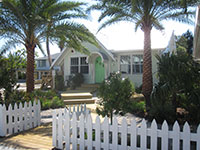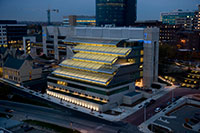
On Anna Maria Island, a barrier island among the chain of Keys along Florida’s Gulf Coast, the Historic Green Village (HGV) aims to create sustainable green buildings, with an ultimate goal of net zero energy.
On Anna Maria Island, a barrier island among the chain of Keys along Florida’s Gulf Coast, the Historic Green Village (HGV) aims to create sustainable green buildings, with an ultimate goal of net zero energy. Three of the buildings are historic buildings that have been donated and in some instances moved from a different location to the site of the HGV.
Incorporating green technologies, The Sears Catalogue Cottage from 1935 is now a vintage boutique and the Rosedale Cottage built in 1913 is now the Village Café. All of the buildings are designed to meet LEED Platinum. It is intended that the HGV will generate more energy than it consumes, in the vision to become the first Zero Net Energy campus in Florida. The site also harvests rain and storm water, and encourages a range of sustainable transportation choices. The HGV campus will be finished in 2012, with the addition of two vacation rental units.
One strategy employed at the HGV is geothermal cooling and heating. A 3 unit 4-ton FHP geothermal HVAC system uses a ground water loop system to provide heating and cooling. The system also has a plate heat exchanger – a device that uses metal plates to transfer heat and to isolate the HVAC loop water from the geothermal wells. Then, once the heat is extracted from the source water, it’s re-injected into the ground through the discharge well.
A Yaskawa variable frequency drive (VFD) adjusts the speed of the pump by controlling the frequency of the electrical power supplied to the motor, providing only the supply that’s needed to keep the system operating properly. During lower demand times, when the VFD is running at 80 percent of capacity, it provides about a 50 percent energy savings, according to the system's designer. And it also eliminates the need for a magnetic starter.












